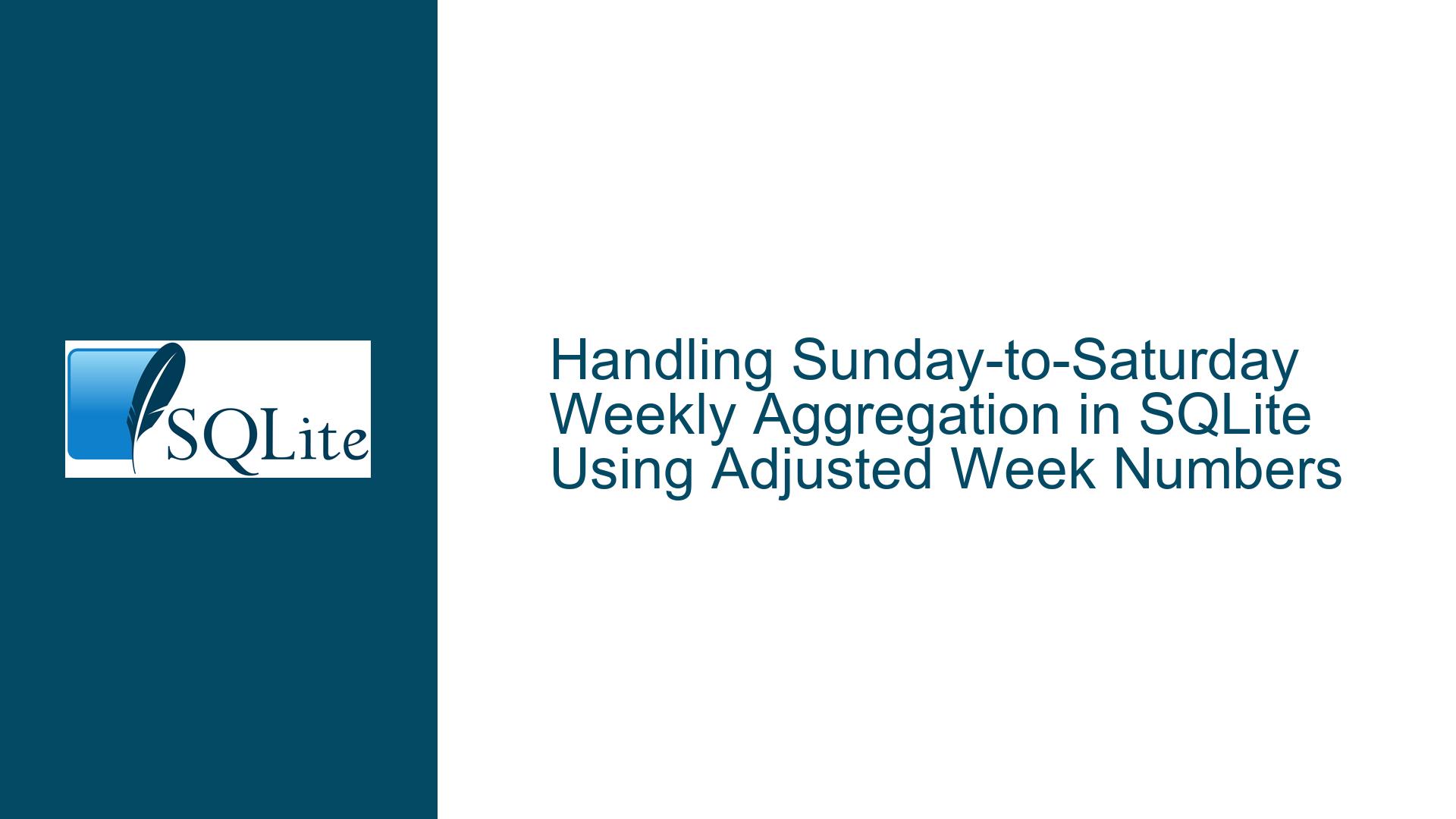Handling Sunday-to-Saturday Weekly Aggregation in SQLite Using Adjusted Week Numbers
Understanding Sunday-Start Weekly Aggregation Challenges in SQLite
Core Challenge: Aligning SQLite’s Monday-Start Weeks with Sunday-Start Reporting Requirements
The central issue revolves around SQLite’s default handling of week numbers (%W), which defines a week as starting on Monday and ending on Sunday. However, the requirement is to aggregate data over weeks starting on Sunday and ending on Saturday. This discrepancy leads to misaligned weekly groupings when using native week number functions. Additionally, the original table schema stores dates as separate year, month, and day columns, complicating date arithmetic and comparisons. The absence of a unified date column forces reliance on string formatting for date operations, introducing inefficiencies and potential errors.
The discussion highlights three critical sub-issues:
- Date Storage Inefficiency: Splitting dates into separate columns complicates query logic.
- Week Number Misalignment: SQLite’s
%Wassumes Monday as the week start, conflicting with the Sunday-to-Saturday requirement. - Data Type Ambiguity: Confusion about whether to use
NUMERICorTEXTfor date storage, given SQLite’s flexible typing system.
Root Causes of Misaligned Weekly Aggregation and Schema Limitations
Date Fragmentation in Table Design
Storing dates as separateyear,month, anddaycolumns forces developers to reconstruct dates dynamically using functions likeformat('%d-%02d-%02d', year, month, day). This approach is fragile because:- String Comparisons Are Error-Prone: Comparing dates as strings (e.g.,
'2023-10-08' <= date_string <= '2023-10-14') relies on correct formatting, which can break if any component (year, month, day) is missing or invalid. - Inefficient Index Usage: The primary key
(year, month, day)is redundant because a singleDATEcolumn can uniquely identify daily records. Fragmented date columns also prevent efficient use of indexes for date range queries.
- String Comparisons Are Error-Prone: Comparing dates as strings (e.g.,
SQLite’s Week Number Convention
SQLite’sstrftime('%W', date)returns the week number based on the ISO 8601 standard, where weeks start on Monday. For example:2023-10-01(Sunday) is considered part of week 39 (September 25–October 1).2023-10-02(Monday) starts week 40.
This conflicts with requirements where weeks should start on Sunday. Without adjustment, aggregating from Sunday to Saturday groups data across two ISO weeks.
Ambiguous Date Type Affinity
SQLite does not enforce strict data types. Declaring a column asNUMERICorTEXTmerely suggests a type affinity. For dates stored in ISO 8601 format (YYYY-MM-DD), usingTEXTis preferable because:- It ensures lexicographical order matches chronological order.
- It avoids implicit conversions when using date functions like
date()orstrftime().
Edge Cases at Year Boundaries
Adjusting week numbers by offsetting dates (e.g.,+1 day) can cause unexpected behavior around January 1st and December 31st. For example, adding a day to2023-12-31results in2024-01-01, which belongs to week 1 of 2024. This may lead to incorrect year assignments in multi-year datasets.
Step-by-Step Solutions for Accurate Weekly Aggregation and Schema Optimization
Step 1: Optimize Table Schema for Date Storage
Replace the fragmented year, month, day columns with a single TEXT or NUMERIC column storing ISO 8601 dates:
CREATE TABLE views (
dayDate TEXT NOT NULL DEFAULT (date('now', '-1 day')),
dayViews INTEGER NOT NULL,
PRIMARY KEY (dayDate)
);
- Advantages:
- Simplifies date comparisons:
WHERE dayDate BETWEEN '2023-10-08' AND '2023-10-14'. - Enables direct use of SQLite’s date functions without string reconstruction.
- Simplifies date comparisons:
Step 2: Adjust Week Start with Date Offsets
To shift the week start from Monday to Sunday, apply a +1 day offset to dates before calculating the week number:
SELECT
strftime('%W', dayDate, '+1 day') AS WeekNo,
MIN(dayDate) AS StartOfWeek,
MAX(dayDate) AS EndOfWeek,
SUM(dayViews) AS WeeklyViews
FROM views
GROUP BY WeekNo
ORDER BY StartOfWeek;
- How It Works:
- Adding a day to
dayDatemoves Sundays (e.g.,2023-10-01) into the same week as the following Monday–Saturday period. strftime('%W', '2023-10-01', '+1 day')calculates the week number for2023-10-02, which is week 40.
- Adding a day to
Step 3: Handle Year Boundaries Gracefully
To avoid misassigning weeks at year transitions, include the year in the grouping:
SELECT
strftime('%Y', dayDate) AS Year,
strftime('%W', dayDate, '+1 day') AS WeekNo,
MIN(dayDate) AS StartOfWeek,
MAX(dayDate) AS EndOfWeek,
SUM(dayViews) AS WeeklyViews
FROM views
GROUP BY Year, WeekNo
ORDER BY Year, WeekNo;
- Why This Matters:
- Prevents weeks in late December from being grouped with early January dates.
- Example:
2023-12-31with+1 daybecomes2024-01-01, which is correctly grouped under 2024’s week 1.
Step 4: Validate Data Completeness
Add checks to ensure no days are missing within a week:
SELECT
WeekNo,
StartOfWeek,
EndOfWeek,
COUNT(*) AS DaysRecorded,
(julianday(EndOfWeek) - julianday(StartOfWeek) + 1) AS DaysExpected,
SUM(dayViews) AS WeeklyViews
FROM (
SELECT
strftime('%W', dayDate, '+1 day') AS WeekNo,
MIN(dayDate) AS StartOfWeek,
MAX(dayDate) AS EndOfWeek,
dayViews
FROM views
GROUP BY WeekNo
)
GROUP BY WeekNo
HAVING DaysRecorded < DaysExpected;
- Output Interpretation:
DaysExpectedcalculates the expected number of days betweenStartOfWeekandEndOfWeek.- Rows where
DaysRecorded < DaysExpectedindicate missing data.
Step 5: Address Edge Cases with Conditional Logic
For datasets spanning multiple years, use a CASE statement to handle weeks overlapping January 1st:
SELECT
CASE
WHEN strftime('%m', dayDate) = '12' AND strftime('%W', dayDate, '+1 day') = '01'
THEN strftime('%Y', dayDate, '+1 year')
ELSE strftime('%Y', dayDate)
END AS AdjustedYear,
strftime('%W', dayDate, '+1 day') AS WeekNo,
MIN(dayDate) AS StartOfWeek,
MAX(dayDate) AS EndOfWeek,
SUM(dayViews) AS WeeklyViews
FROM views
GROUP BY AdjustedYear, WeekNo;
- Logic Explained:
- If a date in December belongs to week 01 (after applying
+1 day), it is assigned to the next year.
- If a date in December belongs to week 01 (after applying
Step 6: Indexing for Performance
For large datasets, create an index on dayDate:
CREATE INDEX idx_views_dayDate ON views(dayDate);
- Impact:
- Speeds up queries filtering or grouping by
dayDate.
- Speeds up queries filtering or grouping by
Step 7: Migrate Existing Data to the New Schema
For users transitioning from the old schema:
-- Create new table
CREATE TABLE views_new (
dayDate TEXT NOT NULL,
dayViews INTEGER NOT NULL,
PRIMARY KEY (dayDate)
);
-- Migrate data
INSERT INTO views_new (dayDate, dayViews)
SELECT
format('%04d-%02d-%02d', year, month, day) AS dayDate,
views
FROM views;
-- Drop old table and rename new one
DROP TABLE views;
ALTER TABLE views_new RENAME TO views;
Step 8: Testing and Validation
Verify the solution with edge cases:
-- Test Case 1: Sunday Start
INSERT INTO views (dayDate, dayViews) VALUES
('2023-10-01', 5), -- Sunday (Week 40 after +1 day)
('2023-10-02', 5), -- Monday (Week 40)
('2023-10-07', 5); -- Saturday (Week 40)
-- Expected Output:
-- WeekNo | StartOfWeek | EndOfWeek | WeeklyViews
-- 40 | 2023-10-01 | 2023-10-07 | 15
-- Test Case 2: Year Boundary
INSERT INTO views (dayDate, dayViews) VALUES
('2023-12-31', 10), -- Sunday (Week 01 after +1 day)
('2024-01-01', 10), -- Monday (Week 01)
('2024-01-06', 10); -- Saturday (Week 01)
-- Expected Output:
-- AdjustedYear | WeekNo | StartOfWeek | EndOfWeek | WeeklyViews
-- 2024 | 01 | 2023-12-31 | 2024-01-06 | 30
Final Notes:
- Always use ISO 8601 (
YYYY-MM-DD) for date storage in SQLite. - Test week-based queries with datasets spanning year boundaries.
- Monitor performance with
EXPLAIN QUERY PLANfor large datasets.
This approach ensures accurate Sunday-to-Saturday weekly aggregation while leveraging SQLite’s native date functions and avoiding common pitfalls in date handling.






